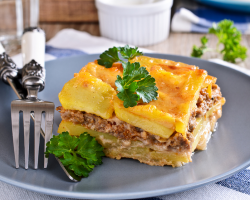In this article, we will consider how to properly sterilize banks with blanks in a pot of water.
When the summer is coming to an end, the main task of each hostesses is the harvesting of fruit and vegetable crop, as well as compotes and much more. And in many recipes, a step with sterilization of cans with blanks is provided. After all, disinfection is necessary in order to destroy microbes that contribute to corruption of conservation. Therefore, we offer to understand this issue in order to do everything right.
How and how much to sterilize banks with blanks in a pot of water?
Despite the fact that the disinfection of containers should be carried out before the start of canning, sterilization of cans with blanks sometimes allows for passage of this step. But also gives guarantees and confidence that it will be simple before the New Year.
Important: sterilization is often carried out for salads, adjiki and other twisting with vegetables. But keep in mind that it is necessary to sterilize banks with blanks without vinegar and a large amount of salt, sugar and acute pepper.
- Before you start the conservation process, look that all banks are intact, without cracks, chips or rust. Rinse the vegetables well so that there is no dirt and other garbage, which can cause swelling. Therefore, it is best to soak the products for several hours in water, and then rinse under running water.
- If you cook the salad, then you need to cook it for the recipe. Just do not lay out immediately in banks. This can cause cracks in banks. So wait, until the mass has cooled to about 70 ° C.

- If you skip a step with preliminary sterilization of empty containers, then be sure to wash cans with soda for disinfection. The covers should also be washed, but either with a detergent or mustard powder.
- Lay out the desired contents in the banks, if necessary, pour the marinade.
- Put any clean fabric in a pan, without a pile, preferably cotton. It is advisable to fold it several times, and even better - use silicone rugs. Pour cans with water, about the same temperature as the blanks inside it. Otherwise, from a sharp temperature difference, the container can burst. Also note that banks should not touch each other.
- Fill the pan with water so that the neck of the jar is open by about 1 cm. As they say, “to the shoulders”. Therefore, do not forget that simultaneously sterilize banks with blanks can only be one size.
- There are several options here. If you have sterilized the covers, then you can still put them aside. But it will be better if you cover them with the contents of the cans. But do not run too tightly! Or decompose between the banks to prevent tank touching.
Important: in order to improve the process of sterilization of cans with twists, it is worth throwing about 2-3 tbsp into the water. l. Salt. Salt solution is better to neutralize the harmful flora, which can lead to corruption of conservation.

- The countdown should be carried out after boiling water. But do not turn on too much fire, let the container heats up gradually. You need to simulate products with products only over low heat!
- The sterilization time of cans with blanks after boiling is completely dependent on the size of the container:
- half-liter jars need to withstand for 10-12 minutes;
- if you have non-standard banks of 700-800 ml, then you are evasing up to 15-17 minutes;
- liter jars must be sterilized for 20 minutes;
- but three -liter - 30 minutes.
- Sometimes the recipe indicates the exact time. Therefore, adhere to it. And do not forget, for example, tomatoes cannot be withstanded too long so that they do not burst.
- When the banks with products are sterilized, we get them using forceps or towels, and immediately roll them up.
- We turn the jars upside down down and wrap well so that the temperature, in the middle, was the same as outside. We are waiting for the finished conservation to cool completely. It will take about a day. Then we send to a cool and dark place.





